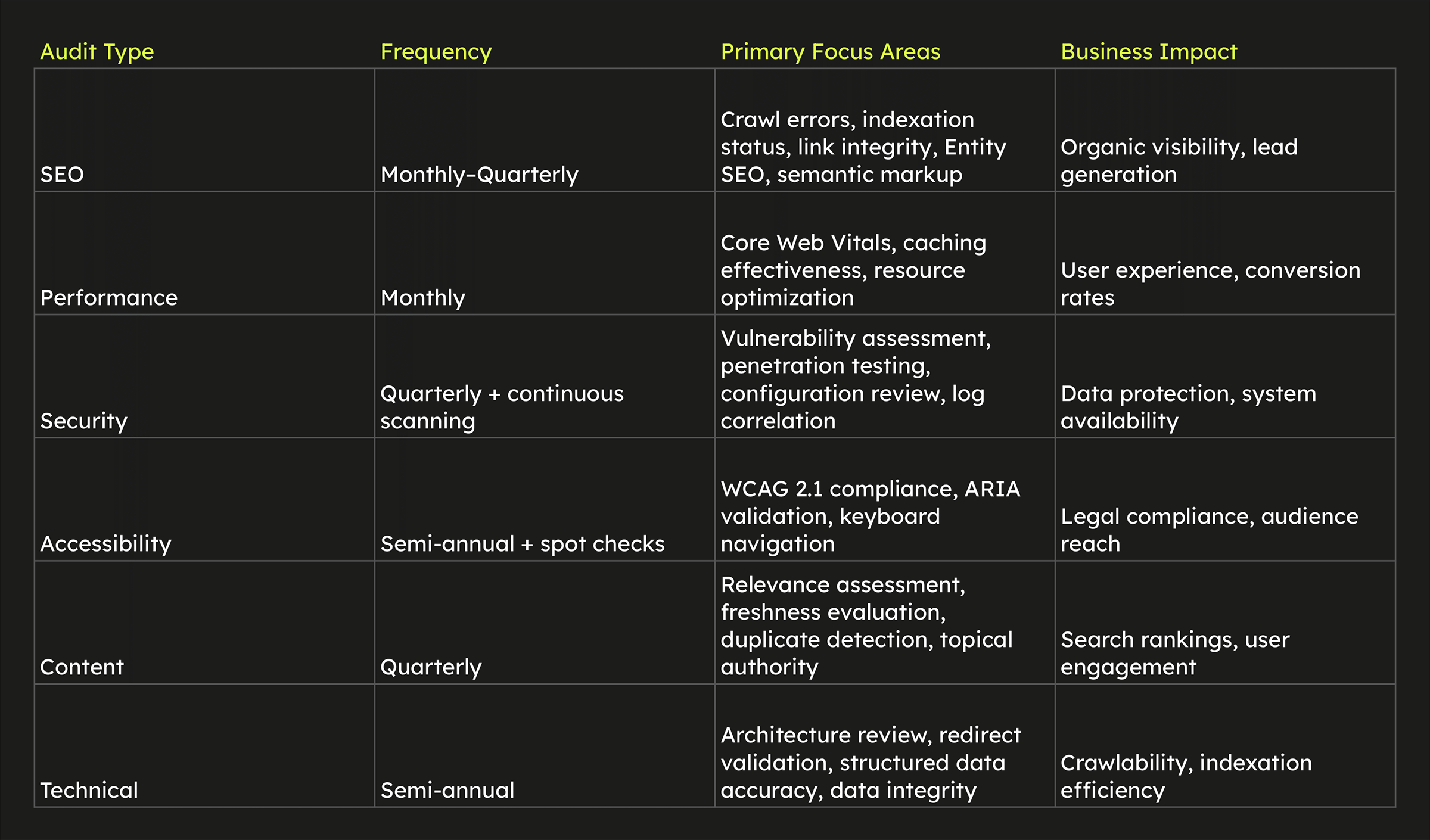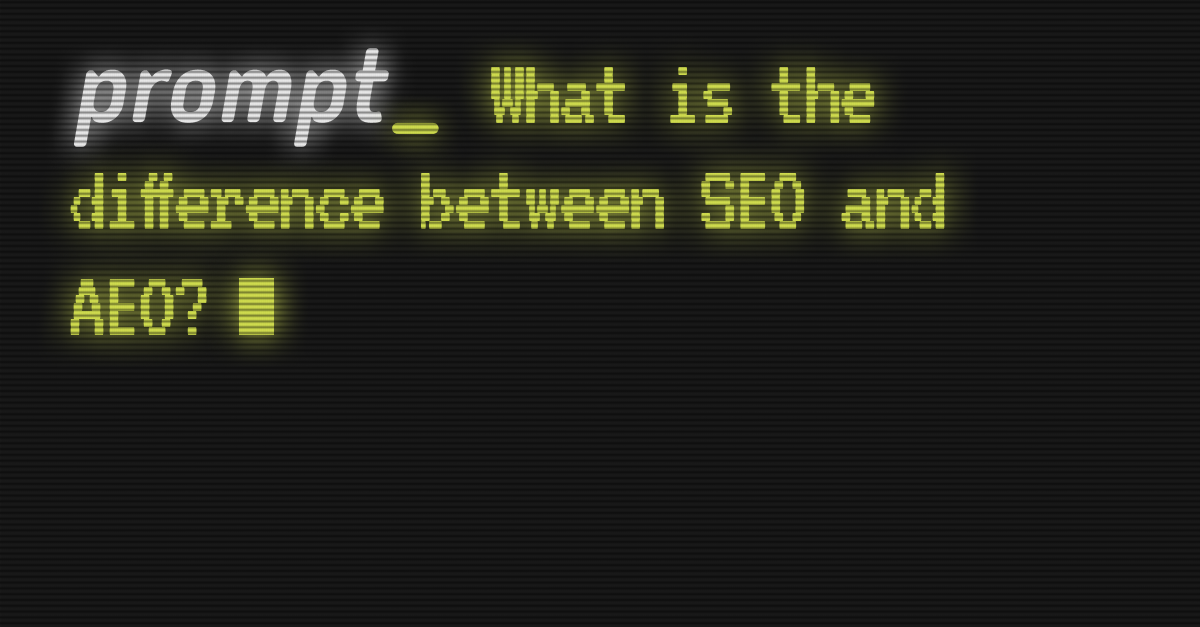How Often Should You Audit Your Website for Security, Performance, & SEO?

Regular website audits protect competitive positioning by identifying vulnerabilities before they compromise performance, security, or visibility. This guide establishes evidence-based audit frequencies across security, performance, and SEO, transforming reactive maintenance into strategic infrastructure management that reduces technical debt and strengthens operational resilience.
A website audit is a comprehensive analysis of a site's technical infrastructure, performance metrics, security posture, and SEO implementation designed to maintain operational health and search visibility.
Whether hardening cybersecurity protocols, optimizing Core Web Vitals, or preserving organic search visibility, the framework below provides actionable cadence recommendations for enterprise technology organizations.
Why are website audits critical for B2B tech companies?
Website audits systematically evaluate security posture, technical SEO implementation, performance metrics, content relevance, and user experience. Early detection prevents cascading failures: outdated plugins become breach vectors, slow pages trigger ranking penalties following the Page Experience Update, broken links erode user trust and data integrity.
For B2B technology firms operating in competitive markets, consistent recdeliver three fundamental protections:
- Security: Proactive vulnerability detection before exploitation
- Performance: Sustained speed and reliability under enterprise traffic volumes
- SEO: Protected visibility and lead generation infrastructure through semantic markup optimization
Regular evaluation cycles reduce operational risk, maintain site health, and support predictable growth trajectories while preventing technical debt accumulation.
What are the measurable benefits of regular website audits?
Disciplined audit programs generate quantifiable operational improvements:
- Security: Reduced attack surface through systematic vulnerability remediation and log correlation
- SEO: Preserved rankings via ongoing optimization, Entity SEO refinement, and structured data validation
- Performance: Faster load times maintaining user engagement and conversion rates
- Compliance: Sustained adherence to GDPR, SOC 2, HIPAA, and industry standards
- Conversion: Eliminated friction points across critical user journeys
- Strategy: Data-driven improvement roadmaps with risk-based prioritization
These benefits compound: secure infrastructure enables better performance, faster experiences drive higher conversion rates, and compliant systems sustain customer trust. Organizations integrating audits into CI/CD pipelines accelerate this reinforcement cycle.

How do security and performance audits work together?
Security and performance audits share significant technical overlap, creating efficiency opportunities when integrated strategically within your website audit framework.
Security audit components
Security assessments identify exploitable weaknesses before threat actors. Vulnerability scanning, penetration testing, and configuration reviews surface outdated CMS plugins, exposed administrative interfaces, and SSL/TLS misconfigurations. Systematic remediation reduces attack surface while supporting continuous availability and data integrity.
Performance audit components
Performance evaluations analyze page load speeds, caching effectiveness, server response times, and render-blocking resources. Priority metrics include Core Web Vitals, Largest Contentful Paint (LCP), Cumulative Layout Shift (CLS), and Interaction to Next Paint (INP, formerly First Input Delay). These are Google's key performance metrics for evaluating real-user experience. Optimization occurs through image compression, script deferral, and resource minimization.
Do performance optimizations ever weaken security?
Rarely, but improper caching configurations or third-party scripts can introduce vulnerabilities. Integration ensures each fix is validated across both domains—preventing speed improvements from creating new attack vectors.
Integration Advantages
Single interventions often strengthen both domains. Implementing a Content Security Policy (CSP), which defines which resources browsers can load to prevent injection attacks, reduces code injection risk while enabling more efficient HTTP/2 delivery. Removing unused JavaScript simultaneously improves page speed and eliminates potential exploit vectors, demonstrating how performance and security audits create compounding value.
Can audit automation replace manual reviews?
No. Automation and manual review serve complementary functions within strategic website audit frameworks.
- Automation Strengths: Speed, consistency, continuous monitoring, breadth of coverage, objective measurement.
- Manual Review Strengths: Contextual interpretation, strategic prioritization, user experience evaluation, competitive analysis, business impact assessment.
High-performing organizations combine both approaches: automation detects issues continuously, while manual reviews provide strategic context and risk-based prioritization necessary for effective remediation sequencing.
How often should you audit your website?
Optimal audit frequency depends on organizational scale, risk profile, regulatory requirements, and deployment velocity. The schedule below establishes baseline recommendations adaptable to specific operational contexts.
Recommended website audit schedule

Trigger Events for Ad Hoc Audits: Major feature launches, platform migrations, algorithm updates, security incidents, traffic anomalies, or regulatory changes.
Why do monthly performance audits matter?
Monthly performance reviews detect regressions early as Google's page experience signals evolve. Automated monitoring tracks daily metrics; manual analysis reveals real-world performance patterns across user segments and conditions.
What's the conversion impact of slow page speeds?
Research consistently demonstrates conversion sensitivity to speed: one-second delays reduce conversion rates by approximately 7%. Regular audits prevent incremental slowdowns from compounding into measurable revenue impact while maintaining alignment with Core Web Vitals benchmarks following the Page Experience Update.
How often should you run security audits?
Security audit frequency should scale with organizational risk exposure and technical debt levels:
- Automated vulnerability scans: Monthly minimum (weekly or daily for high-risk environments)
- Penetration testing: Quarterly for standard risk profiles
- Compliance audits: Annual (SOC 2, ISO 27001, HIPAA, PCI DSS)
- Configuration reviews: After every infrastructure change or major deployment
Threat landscapes evolve continuously. Consistent assessment cycles ensure defensive postures adapt appropriately while log correlation reveals emerging attack patterns.
When should you audit accessibility, content, and technical architecture?
Accessibility: Comprehensive semi-annual audits with quarterly spot checks for new content releases or interface updates. Accessibility gaps create both legal exposure and SEO penalties, as semantic markup improvements enhance both user access and search engine understanding.
Content: Quarterly reviews to refresh high-value pages, retire obsolete material, consolidate thin content, and validate metadata alignment with search intent. Enterprise SEO audits should emphasize Entity SEO and topical authority development.
Technical: Semi-annual comprehensive assessments with targeted spot checks after structural modifications affecting site architecture, URL hierarchies, or data layer implementations.

When should you run full website audits vs targeted spot checks?
Full audits provide comprehensive evaluation across all systems and should occur:
- On established schedules (quarterly, semi-annual)
- After major platform migrations or redesigns
- Following significant algorithm updates
- During compliance certification periods
Targeted spot checks focus on specific subsystems and should occur:
- After feature deployments within CI/CD pipelines
- When monitoring alerts indicate anomalies
- Following minor content or configuration updates
- Between scheduled full audits to validate continuous improvement
Strategic website audit frameworks balance comprehensive evaluation with targeted validation, preventing both audit fatigue and blind spot accumulation.
How do you build a strategic website audit framework?
Effective audit strategies treat websites as integrated systems where modifications in one domain create cascading effects across others. Siloed audit approaches introduce blind spots and unintended regressions.
Cross-domain impact assessment
JavaScript removal improves performance metrics while reducing exploitable code surface area. ARIA attribute corrections enhance accessibility compliance while improving semantic crawlability for Entity SEO. URL restructuring for SEO requires validation through performance and security lenses to prevent introducing vulnerabilities or speed regressions.
Operational integration
Embed audit cycles into existing governance structures: sprint retrospectives, quarterly business reviews, or CI/CD pipeline validation. Treat audits as continuous feedback mechanisms rather than periodic inspection events, reducing technical debt accumulation through sustained iteration.
Iterative improvement philosophy
High-performing digital ecosystems evolve through sustained iteration. Each audit cycle generates prioritized improvement backlogs using risk-based prioritization that inform subsequent development sprints, creating compounding performance gains over time.
Organizations adopting this approach transform their website audit schedule from reactive maintenance into strategic competitive advantage.
What should a comprehensive website audit include?
Technical foundation and SEO health
Verify robots.txt directives and XML sitemap accuracy; identify crawl errors, broken links, and indexation issues; validate canonical URL implementation and redirect chain efficiency; audit Schema.org structured data for accuracy and completeness, emphasizing semantic markup and Entity SEO signals; confirm mobile-first indexing readiness and responsive design consistency; review hreflang annotations, pagination handling, and information architecture supporting topical authority.
Performance optimization
Measure Core Web Vitals (LCP, INP, CLS) using field data from real users; analyze waterfall charts to identify render-blocking resources; confirm compression implementation across images, CSS, and JavaScript; evaluate server response times and CDN configuration effectiveness; test load performance across device types, connection speeds, and geographic regions; validate performance budget adherence within CI/CD pipelines.
Security Hardening
Execute automated vulnerability scans across all site components; verify SSL/TLS configuration strength, HSTS implementation, and Content Security Policy headers; identify exposed administrative interfaces and outdated plugin versions contributing to technical debt; review user role hierarchies, access control policies, and authentication mechanisms; conduct periodic penetration testing; monitor security logs, implement log correlation for threat detection, and maintain incident response documentation ensuring data integrity.
Accessibility and content quality
Validate WCAG 2.1 Level AA compliance including color contrast ratios, keyboard navigation patterns, and alternative text coverage; test ARIA attribute implementation and screen reader compatibility; surface thin, duplicate, or outdated content requiring refresh or consolidation; confirm metadata alignment with target search intent and brand messaging standards; evaluate internal linking architecture supporting Entity SEO and topical entity coverage through semantic markup.
Post-audit workflow
Document findings in centralized reports accessible to relevant stakeholders; apply risk-based prioritization considering business impact, implementation complexity, and security severity; assign ownership, establish deadlines, and track progress through existing project management systems; integrate remediation into CI/CD pipelines where appropriate; re-test after implementation to confirm successful resolution and prevent regression.
What are the most common website audit mistakes?
Organizations frequently compromise audit effectiveness through these preventable errors.
- Skipping post-migration audits: Major platform changes introduce configuration gaps and broken dependencies requiring immediate validation to prevent technical debt accumulation.
- Over-reliance on automation: Automated tools provide breadth; manual review provides critical context and strategic insight. Both are essential within effective website audit frameworks.
- Ignoring accessibility and structured data: These elements directly impact both legal compliance and search visibility through semantic markup, yet frequently receive inadequate attention in enterprise SEO audits.
- Treating audits as projects rather than programs: One-time audits identify current issues. Continuous audit programs prevent future problems and sustain operational excellence through integration with CI/CD pipelines and risk-based prioritization.
Strategic audit cadence
Disciplined website audit schedules don't merely prevent problems, they power sustained competitive performance. Strategic audit programs transform reactive maintenance into proactive optimization, identifying opportunities before competitors while preventing issues before they impact users or revenue.
Organizations that embed audit discipline into operational rhythms maintain faster sites, stronger security postures, and better search visibility than competitors relying on reactive maintenance approaches. Integration with CI/CD pipelines, risk-based prioritization frameworks, and continuous log correlation creates compounding advantages: reduced technical debt, improved data integrity, stronger Entity SEO signals, and enhanced semantic markup supporting both user experience and search performance.
Performance and security audits conducted on disciplined schedules within comprehensive website audit frameworks transform infrastructure evaluation from cost center to strategic differentiator.
Ready to transform your audit approach into strategic infrastructure?
Partner with Prompt Digital to design an audit program that scales with your business objectives and technical complexity, converting your website audit schedule from defensive posture into offensive competitive advantage.
The Prompt Team is our collective of designers, developers, and strategists translating real project experience into clear, useful insights. Each article reflects our team’s combined expertise, a practical approach to helping brands navigate digital design, strategy, and growth with confidence, clarity, and purpose, built on years of collaboration, curiosity, and hands-on results.
Daniela keeps Prompt running with clarity and momentum, managing internal operations, optimizing workflows in ClickUp, and leading the team’s social media presence. A SearchAtlas expert fluent in SEO and AEO best practices, she connects process and performance to keep every system, and story, aligned.











